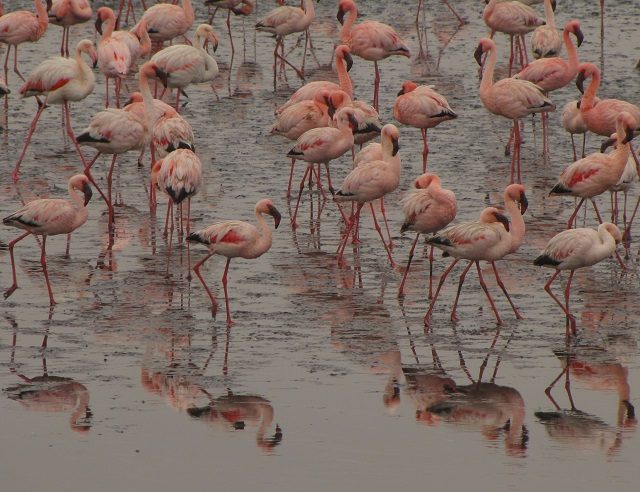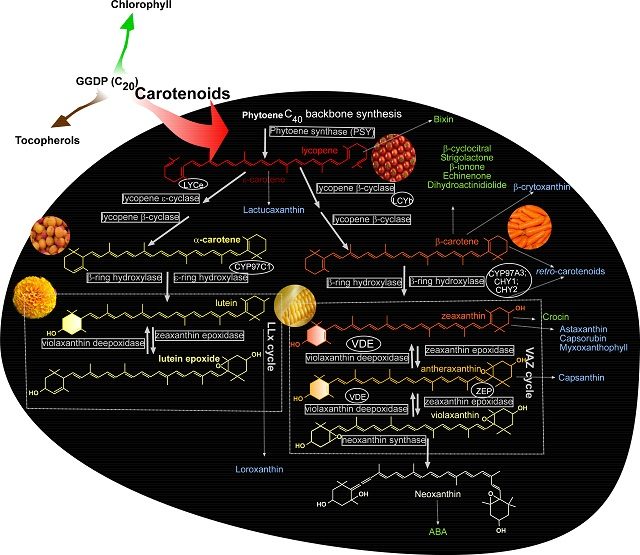Carotenoids, I see your true colours

When autumn arrives to temperate climate forests, deciduous trees lose their characteristic green tonalities and start showing a wide spectrum of new colours: yellow, brown, orange, red… Chlorophyll reabsorption takes place in the leaves and carotenoids, present in a lower concentration, are exposed. These pigments are produced in all photosynthetic organisms, fungi and non-photosynthetic bacteria. When a natural tissue is orange, reddish or yellow it is very probable that carotenoids are involved. Think about crabs, oranges, tomatoes, salmon, flamingos, egg yolks or pumpkins: carotenoid reservoirs for sure!
Carotenoids play diverse roles on plants: not only do they participate in photosynthesis as light harvesting pigments, but also as photoprotective and assembling structures. They have been identified as plant signalling molecules and their role in plant-environment interaction is essential. Three arthropod species biosynthesize carotenoids due to gene lateral transfer from fungi but the rest of animal species require an external input. Most of carotenoids are precursors to vitamins and play a part in tissue pigmentation: feathers, crustacean carcasses, skin, etc. Vitamin A, fundamental for growth, the immune system and good vision, is synthesized from ß-carotene, highlighting the importance of these biomolecules in health, cosmetics and pharmaceutical industry.
Biochemically speaking these compounds are lipids, more concretely tetraterpenes, and their structure is based on a 40-carbon polyene chain with conjugated double bonds along the carbon skeleton. Variations on the carbon chains (oxygenation, hydrogenation, cyclization at the end of the molecule and length of the chromophore) result in the diversity of carotenoids found in nature. There are 750 types of naturally produced carotenoids. Despite this variety, the most abundant ones are basically three: fucoxanthin (brown), lutein (yellow) and ß-carotene (orange).

Plastids are the carotenoid fabrication facilities inside the cells. The biosynthetic route involved is called the “1-deoxy-D-xylulose 5-phosphate pathway” and always starts with the colourless molecule phytoene, a C40 carotenoid formed by condensation of two molecules of geranylgeranyl pyrophosphate (C20PP) by phytoene synthase (PSY). C20PP is in turn a precursor to chlorophylls and tocopherol. After four desaturation reactions phytoene is transformed into lycopene, the molecule that gives the red colour to ripe tomatoes. Lycopene leads to α- and ß-carotene and subsequent chemical reactions produce xanthophylls: lutein, zeaxanthin, antheraxanthin, etc (Figure 1)1.
Parallel roles
Although carotenoids play different roles in plants and animals there are some curious analogies. In both taxa they are involved in photoreception/photoprotection, bio-communication and antioxidant defence.
Carotenoids are known to complete the photosynthetic machinery in plants by harvesting light in the spectral region not accessible to chlorophylls and transferring it to them. Animals also need carotenoids for the visual process. Vitamin A in the form of retinal is combined with opsins to form rhodopsin, the protein that provides us with vision. Besides light reception, carotenoids protect organisms from an excess of sunlight. In plants, there is a high risk of forming reactive oxygen species (ROS) derived from the photosynthetic process. In this context, carotenoids act as “sunglasses” protecting the plant when luminous energy is too elevated, converting it into heat. This is energy dissipation: the excess of light induces the xanthophyll cycle (VAZ) and violaxanthin (V) is deepoxidated to anteraxanthine (A), which is then transformed into zeaxanthin (Z). As to animals, carotenoids protect both vision and skin. Lutein and zeaxanthin give name to the macula lutea of the retina, a yellow structure that enhances vision. These pigments perform their protective role throughout two mechanisms: as blue light filters and as 1O2 quenchers. Carotenoids have been proved to scavenge compounds resulting from photooxidative damage to the skin in erythropoietic protoporphyria, erythema and photoageing.
Carotenoids oxidation products act as signalling molecules under oxidative stress. For instance, ß –cyclocitral, a volatile compound that gives flavour to many vegetables, is involved in high light stress and photo-acclimation. Dihydroactinidiolide inhibits plant germination and appears to be cytotoxic to cancer cells. Carotenoids are also linked to phytohormones as some of them are direct derivatives. Absicic acid (ABA), responsible for seed germination, plant growth and a stress mediator, and strigolactones, are two examples. In fact, strigolactones have recently emerged as phytohormones and they stimulate germination of parasitic weeds and also participate in the control of root-hair formation, shoot branching, and the communication with other hormones. Moreover, plants have molecules involved in colour, fragrance and flavour, and, once again, these are carotenoid oxidation derivatives. Some of these compounds are of great commercial value. For instance, crocetin glycoside is a red pigment obtained from Crocus sativus and is responsible for the colour of saffron. On the other hand, ionones, volatile derivatives, are frequently used in the agri-food industry and cosmetics for their aromatizing power.
It is widely acknowledged that carotenoids have antioxidant properties. They are effective ROS quenchers and scavengers and as mentioned before some of them react with 1O2 to form volatile molecules and alert plants of oxidative stress. Aside from ß-carotene, lutein and neoxanthin have also been reported as superoxide scavengers. There is a beautiful synergy between carotenoids and other plant molecules to accomplish their antioxidant role. VAZ pigments, along with superoxide dismutases, protect the photosynthetic structures in pea plants grown under high irradiance with ammonium as a nitrogen source. A similar alliance is observed with zeaxanthine, ß-carotene and tocopherols. A few years ago it was discovered that protection from peroxidation is achieved by carotenoids through modulation of membrane fluidity. In animals, oxidative and pathological processes go often hand in hand so it could be deduced that carotenoids play a fundamental part in improving our health. In fact, there are recent epidemiologic studies supporting this hypothesis, although underlying mechanisms have not been yet revealed. So, just in case, put some carrots on your shopping bag once in a while…
Increasing carotenoid contents in food
As it was previously mentioned, implementation ofcarotenoids on the diet seems to be picking the winners. There is broad evidence that carotenoids help to prevent degenerative diseases and cancers. On the other side, vitamin A deficiency affects 20 % of children in lower-income countries provoking blindness. On this context, it seems urgent to pursue the accomplishment of the so-called biofortification policies to enhance carotenoid contents in agronomic species, either by means of genetic engineering or environmental approaches. The latter refers to application of our understanding of metabolism and genetic expression of carotenoids to increase contents in crops, since many steps of the biosynthetic pathway are regulated by environmental factors. To give you an idea, the overexpression of PSY results in increased carotenoid content on harvest, and such overexpression responds to environmental aspects. For instance, high irradiance induces the ß -pathway (Figure 1) and zeaxanthin contents rise, which is positive as this xanthophyll protects human retina. In tomato, lycopene contents rise when exposed to direct sunlight or when decreasing storage temperature. In spinach zeaxanthin contents may be enhanced 15- to 30-fold when applying pre-and post harvest treatments.
In this text just a few rough outlines about carotenoids were pointed out, but these molecules have much more to offer. These ubiquitous pigments are the main characters of essential mechanisms in living organisms and they deserve further attention. Next time you look around and those warm, lovely colours draw your attention, remember that they are not just attractive: their real beauty lies within in the form of fabulous biochemical and physical features.
References
- Esteban R., Moran J. F., Becerril J. M., García-Plazaola J.I.. (2015) Versatility of carotenoids: An integrated view on diversity, evolution, functional roles and environmental interactions. Environmental and Experimental Botany. 119: 63 – 75. doi: 10.1016/j.envexpbot.2015.04.009 ↩